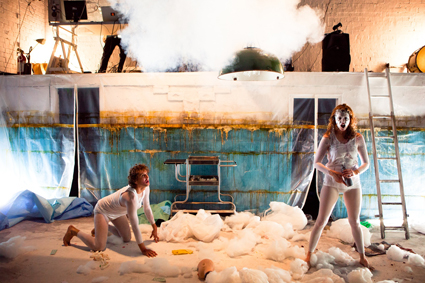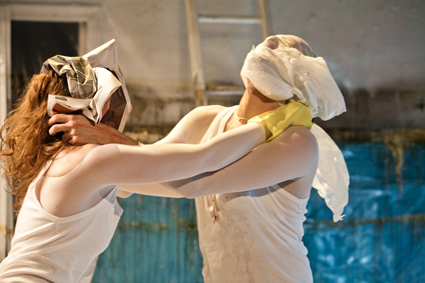breakdown of the break-up
matthew clayfield: trapture, sands through the hour glass

Simon Corfield and Sarah Enright, Trapture
photo courtesy of the artists
Simon Corfield and Sarah Enright, Trapture
ALL PLEASANT BREAK-UPS ARE ALIKE; EACH UNPLEASANT BREAK-UP IS UNPLEASANT IN ITS OWN WAY. WHICH IS WHY THE ONE AT THE HEART OF SARAH ENRIGHT AND SIMON CORFIELD’S TRAPTURE IS SUCH A CURIOUS THING: BY ATTEMPTING TO COVER THE UNPLEASANT BREAK-UP FROM EVERY CONCEIVABLE ANGLE—TO GIVE US, IN A SENSE, THE UR-BREAK-UP—THE PRODUCTION DOESN’T GET TO THE ESSENCE OF THE MESSY SEPARATION SO MUCH AS MERELY PRESENT US WITH A GENERALISED SURVEY OF ITS MOST COMMON AND PREDICTABLE FORMS. THE RESULT IS A PAGEANT OF MILLS & BOON METAPHORS LITERALISED AS STAGE GROTESQUERIES: AN AT TIMES HILARIOUS, BUT ALWAYS SUPERFICIAL, BREAKDOWN OF THE BREAK-UP.
The evening begins with an embrace. Enright, her mouth taped up and her wide, slightly unhinged-looking eyes meeting yours, takes your ticket, asks with a silent gesture if you would like a hug, and then takes you in her arms. The Old Fitzroy’s little theatre has been done up to resemble one of those plastic-draped rooms in otherwise empty warehouses where psychopaths wine and dine their victims before hacking them to pieces. This, as we will soon learn, is appropriate: of all the things to which Enright and Corfield compare the break-up, the most notable are disembowelment and related acts of torture. The central conceit of the piece is to realise emotional violence as physical violence.
This is, of course, something we do every day when we equate the two in language. A pleasant break-up is what you get when both parties choose to “end the relationship.” An unpleasant one is what you get when the metaphors start creeping in: when the man “emotionally raped me” or the woman “tore my heart out.” Men become “pigs” and women “bitches.” One party claims the other can “eat my shit.” For Pat Benatar love is a “battlefield.” Kramer Vs Kramer and The War of the Roses—Danny De Vito’s, not William Shakespeare’s—incorporate this idea of conflict into their titles. And Trapture seeks to give each of the above its time in literalism’s spotlight.
The show begins with Enright and Corfield dressed for a fancy date, making their way to a couch at the far side of the stage. She blindfolds him—he thinks it’s foreplay—before taking out a suitcase, throwing a few things into it and leaving him sitting there. When he finally realises what has happened, things really begin to fall apart: Enright re-emerges, dressed in surgical garb and gives her former partner a sex-change operation. Sporting a Koskian prosthetic and killer heels, Corfield waves his new vagina around in the faces of those in the front row. The performers climb into the audience, invading personal space. Masks emerge. Corfield becomes a pig and Enright a dog, the former forcing the latter to eat his shit and smearing it across her mouth. They throw bedpans of urine at one another.

Sarah Enright and Simon Corfield
photo courtesy of the artists
Sarah Enright and Simon Corfield
In the production’s most graphic and unsettling scene, Corfield dons a clown mask and rapes Enright. She gets her revenge by sticking her hand into his chest and tearing out a cow’s heart. It’s an image straight out of The Simpsons episode “New Kid on the Block” and it is difficult for anyone familiar with that episode to take its recreation here very seriously. Indeed, I found myself marvelling less at the literalisation of the metaphor—which, as The Simpsons’ writers understood only too well, is not so much profound as hilarious—than at the fact that the actor had been wearing a bloody bovine organ strapped to his chest for the duration of the performance. Enright cooks the heart on a portable hotplate and feeds it to him. She eats a slice, too. An unholy communion.
All of this is rendered in a visual style reminiscent of visual artist and filmmaker Matthew Barney. Indeed, if Barney were to direct Artaud’s Jet of Blood, he might come up with something like Trapture. Only he wouldn’t. Barney’s use of metaphor is elaborate where Trapture’s is simplistic, providing his work with its deep, architectonic structures which are almost impenetrable. In contrast, Trapture’s structure is not even really that of a break-up, but rather a shopping list. And it’s a shopping list that, in the end, doesn’t really amount to much: referring back to a non-specific idea of a break-up—to the words we use to describe them—even the impact of the rape is lessened.
Shocking stage images, it seems to me, are becoming increasingly less shocking. I would argue that Sydney hasn’t seen a genuinely cutting one since Kosky put Robyn Nevin in Abu Ghraib for The Women of Troy (2008). As with Simon Stone’s Baal at the Sydney Theatre Company, which seems pitched to offend only a certain strata of the audience (namely the aging subscriber base), Trapture seems to suffer from putting too much stock in the inherent force of its images. That force is lessened the more it’s relied upon. It becomes increasingly difficult to care about, to invest in such images, which have less and less to do with the emotional content of an idea and more and more to do with their capacity to inspire walk-outs. Pass the heart.
Sands Through the Hourglass in association with Tamarama Rock Surfers, Trapture, director Shannon Murphy, conceived & performed by Sarah Enright and Simon Corfield, live sound design Basil Hogios; Old Fitzroy Theatre, Sydney, April 21-May 14. Trapture by Sands Through the House Glass won Best Show Sydney Fringe 2010.
RealTime issue #103 June-July 2011 pg. web






